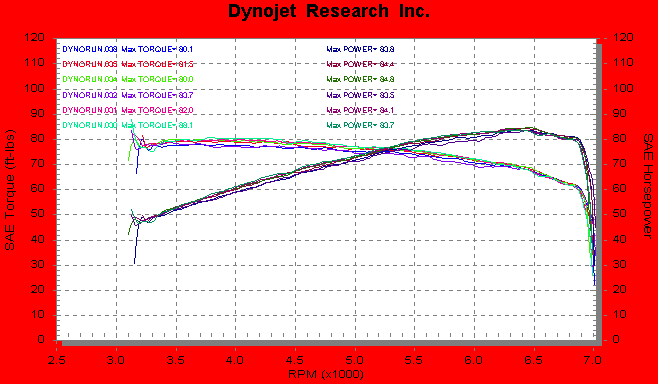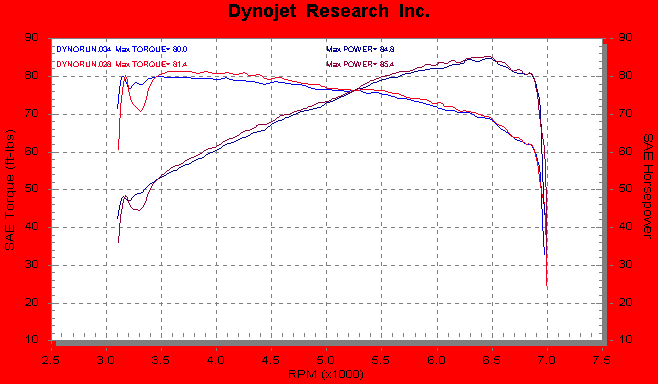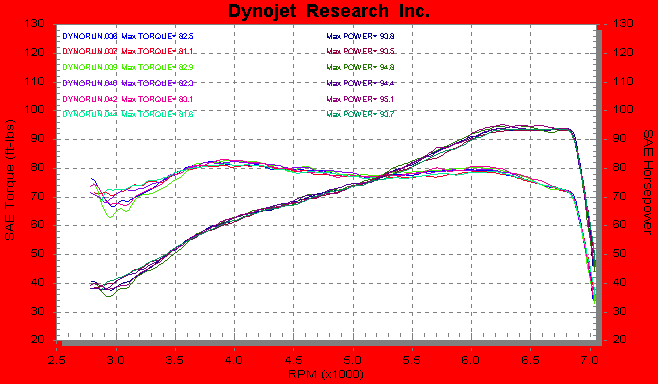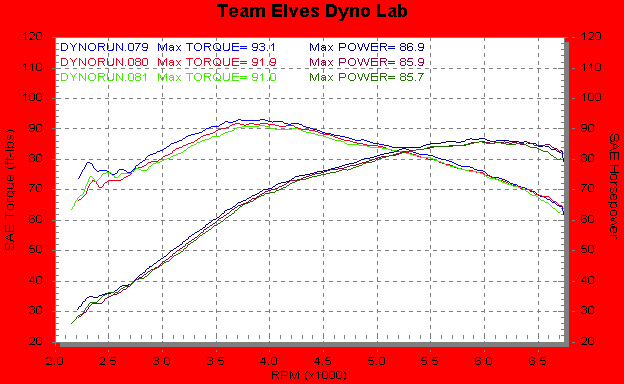Do Crank Vents work?
This is a common question to Nightrider's Motorcycle Performance
Guide technical support line. We attempt to provide an answer this
question.
| Update: January 2002
Nightrider was contacted by the supplier of the
"Krank Vent", ET
Performance. They have asked Nightrider to "retest"
their products under closely controlled conditions on our two test
bikes (80 CID and 97 CID EVO engines). We have attempted to meet the
proper installation conditions as defined by Krank
Vent. Two of the primary installation requirements listed by the
company are a completely air tight engine and removal of the
umbrella valves in the rocker boxes. Although Nightrider has been
unable to ensure that both these conditions have been met on the
test bikes some dyno testing was conducted.
To date, dyno testing has been inconclusive with no differences in
dyno runs we have conducted. In support of the Krank Vent we have
been unable to create a tightly sealed engine on the 97CID engine
and did not remove the umbrella valves from the 80 CID engine. We do
find it disturbing that a simple "bolt on" approach does
not seem to apply to these products. To ET Performances credit, they
have not pressured Nightrider to publish anything other than
information that we are comfortable with. They have also been
helpful in offering assistance and suggestions on letting the Krank
Vent work as advertised. We find it difficult to fault their
attitude and belief in the product.
At this point in time, Nightrider can only state that it finds the
Krank Vent an effective way to reduce blown rocker box gaskets and
the associated oil leaks this problem leads to. Nightrider will
continue to report on new dyno results as they come available. |
|
Hayden Enterprises told Motorcycle Consumer News (MCN) in August
2001 that their crank vent is to prevent blown rocker box gaskets on
EVO engines. There is no benefit to Twin Cam engines. MCN simply
states "The Krank Vent is a waste of money" |
Nightrider's Motorcycle Performance Guide can not state that the use of
any Crank Vent will enhance the performance of an engine although we
have strong subjective evidence that the devices are effective in reducing
blown rocker box gaskets. We can state that these devices will not
hurt performance. Dyno testing
described below by Aaron Wilson of Team
Elves Racing does seem to supports this position. Claims of improved performance by
the various manufacturers of the crank vents have been difficult to
substantiate by testing. Counter claims by manufacturers of crank
vents that testing was not properly conducted have also been leveled. Are
these devices anything more than expensive PCV valves? Probably not, but
this does not mean that the "one way" valve principle used in
these devices is wrong. Racers do use vacuum pumps to reduce crankcase
pressure in engines. Does this racing trick translate to street power?
Nightrider will continue to investigate and report its findings. |
| Crank Vent Dyno Testing by Aaron Wilson
The first time I did this was on my S1 only, Don Casto and I spent several
hours testing both the Hayden and Spyke brand devices. The results were
published in Battle2win awhile back. We also did some other things trying
to influence the power of the bike with the breathers, like plugging them,
and connecting a vacuum pump. Bottom line, the only thing that really gave
a result was the act of pulling them out of the intake stream. That gave a
nice 1 to 2hp gain over a wide rpm range. Nothing else seemed to matter at
all.
That article generated quite a response from one of the manufacturers, ET
Performance, who apparently makes the Spyke device. They really took
exception to it. So in the interest of fairness, I retested the Spyke
device on 4 bikes. Here are the results of that testing.
It's very important to understand that dyno results are not 100%
repeatable. The temperature of the motor, and the "heat soak"
effect, can really play hell with the repeatability. When you're looking
for potentially very small differences, the only solution I've found is
lots and lots of pulls, playing the heat soak rhythm. That's a whole other
discussion, though. Here I'll post enough sheets that you can see the
range of results in each configuration. One of the nice things about
putting the results here, versus Battle2win, is I can post a whole lot
more data.
Something else I'd like to point out, too, is that you have to pay
attention and be careful when you're doing this kind of testing to keep
from being fooled. For example, I had a guy write to me and tell me how he
got 1-2hp with a crank vent device. When I queried him about his testing
procedures, it turned out he had done some baseline pulls, then pulled the
breather from the air cleaner and attached the Spyke device and did some
more pulls. So he inadvertently changed 3 things: he removed the blow-by
from the intake, left the hole in the air cleaner thereby allowing more
air into the air box, and attached the device. He had no idea which of the
3 things changed his power, yet he was crediting the vent device!
One last note and then we're on to the results. Several people have tried
to make the claim that even though it doesn't show up on the dyno, their
engine revs up quicker with the device. That is total BS, folks. A Dynojet
like this one literally measures how long it takes to spin up the drum. If
it spins up faster, it'll show more torque and hp, period.
Okay, enough background, here are the results ...

Here are all the baseline pulls on my '99 M2, no breather check valve in
place other than the factory umbrella valves. The peak power ranges from
84.1 up to 85.4. Mikuni and a Bullett muffler and an air cleaner, that's
it (not bad for a near-stock M2, eh? It's done a lot of dyno time).

Here are all the pulls I did on the same bike, same day, with the Spyke
device in place. The power varies from 83.5 up to 84.8.

Blue: With Spyke Device
Red: Without Spyke device
And of course, this the best pull from each configuration, overlaid onto
the same chart. Yeah, I know, it *looks* like the bike ran a tad better
without the device, but it didn't, this is normal variation. I guarantee
you if I did enough pulls with the device, and played the heat soak just
right, I could've equaled the other results. This is a tie.

Here are all the baseline pulls on my '96 S2. The power varies from 85.9
up to 87.1. Pretty fair for an S2 ... this bike has Brian's stage 1 work
on the stock Sportster heads, a set of N4 (Lightning) cams, a race kit
module, and a V&H muffler. Stock CV carb.

Here are all the pulls I did on the same bike, same day, with the Spyke
device in place. The power varies from 84.7 up to 87.4.

Blue: With Spyke device
Red: Without Spyke device
This the best pull from each configuration, overlaid onto the same chart.
Again, it's a dead heat.

Here are all the baseline pulls on my '96 S1. The power varies from 92.6
up to 95.3.

Here are all the pulls I did on the same bike, same day, with the Spyke
device in place. Pulls 38 and 43 are omitted, because the tach pickup
screwed up and if I put those on the chart, I can't show rpm and torque.
They were not as good as pull # 42. The power varies from 93.7 up to 95.1.

Blue: Without Spyke Device
Red: With Spyke device
(sorry for the color inversion vs. the other results)
This the best pull from each configuration, overlaid onto the same chart.
Again, it's a dead heat. I didn't actually use the "best"
baseline pull, this one has a tad less peak hp but a little nicer curve.

Here are all the baseline pulls on my '90 FXR. This is a little different
animal from a Buell, in that it breathes off the lower end using a timed
breather gear. I don't believe there's actually a check valve in place.
There are only 3 "baseline" pulls because this was a tune-up,
and I did all my tuning that day with the device in place. Only towards
the end, when I had it all tuned up, did I remove the Spyke device for
comparison purposes. As you can see, the power varies from 85.7 to 86.9.
This is a classic "heat soak" set, too ... notice how the first
one is the best, then they fall off. Let it cool for 7-8 minutes and do
this again, and once again the first one will be far and away the best.
Torquey somebitch, huh? Has Brian's stage 1 work with a Crane 316 &
Mikuni.
I've learned a few tricks for generating legible dyno sheets from Winpep,
too.

Here are all the pulls I did on the same bike, same day, in the final
tuning configuration, with the Spyke device in place. The power varies
from 86.2 up to 86.6.

Blue: With Spyke Device
Red: Without Spyke device
This the best pull from each configuration, overlaid onto the same chart.
Again, it's a dead heat.
Bottom line here, folks, I tried my damndest, I can't find power with
these devices. I know that pisses some people off. All I have to say is
"show me". Don't just show me a result, either, show me
procedures and ranges of results.
|
By Permission, Copyright 2001 Aaron Wilson
aaron@aswracing.com
http://www.teamelves.com
Aaron Wilson is an Electrical Engineer from Berthoud,
Colorado. He's been riding motorcycles for over 30 years. He is currently
the Crew Chief for Team Elves Racing. Team Elves currently holds several
Land Speed Records at Bonneville on their Buell. Other competition
experience is primarily sports car racing, having competed in SCCA Solo 1,
Solo 2, GT-1, and Trans-Am over a period of 17 years, and he has dabbled
in drag racing several times as well. He holds the GT-1 course records at
two hill climbs and one Colorado region track. |
| |
|